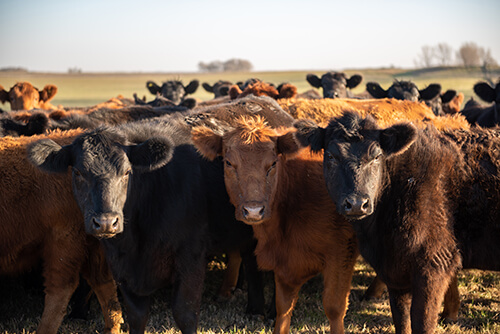It’s That Time Again!
May 18, 2020

Spring doesn’t just mean hard work for farmers planting their crops and cutting hay, it’s also an important time for livestock producers — as they round up their cattle for vaccinations.
Whether you’re an seasoned livestock owner or just beginning, deciding “what and when” of vaccinations can be a challenge — but vital for healthy and thriving cattle.
A quick reference for “what” and “when:”
Cows should receive a vaccination for IBR, BVD, PI3, BRSV, LEPTO and, if natural breeding, VIBRIO.
Calves that are three months and older need to be immunized against IBR, BVD, PI3, BRSV, and BLACKLEG. HAEMOPHILIS SOMNUS can also be added as necessary and booster doses should be given at three to four weeks if it is the first vaccination for the calf.
A quick guide to diseases and symptoms:
IBR or Infectious Bovine Rhinotracheitis — This virus is also known as Red Nose. Animals have high temperatures (108 degrees) and lots of nasal discharge, coughing, and increased respiration. Their muzzles may be reddened or encrusted, with lesions in the mouth and nostrils. In many cases, it will affect the eyes as well, often exhibiting as runny eyes, which can be confused with pinkeye. Abortions are also possible.
BVD or Bovine Virus Diarrhea — BVD is immunosuppressive and can interfere with the normal function of the immune system. This disease affects the digestive and respiratory tracts. Symptoms include high temperatures, nasal discharge, poor or no appetite, and respiratory problems. Watery, light brown or yellowish diarrhea is common. In some cases, however, there is no diarrhea. Sometimes pieces of intestinal wall or tissue are found in the feces. Some cases are mild and go unnoticed.
PI3 or Parainfluenza-3 Viral Infection — Also know as bovine flu, PI3 usually causes little damage in itself but predisposes the animal or opens the door for secondary bacterial infections such as pneumonia. Symptoms are similar to other viral respiratory diseases and include runny eyes, nasal discharge, lung congestion, coughing, dehydration, and muscle trembling.
BRSV or Bovine Respiratory Syncytial Virus — Symptoms include high temperatures (104-108 degrees). Initial exposures to younger animals seem to be most severe. Older animal exposure usually results in milder cases. Depression, decrease in feed consumption, increased respiratory rate, cough, and nasal discharge are the most common symptoms. Secondary bacterial infections such as pneumonia or pasturella often follow this virus infection.
The next step:
The good news is, there are a number of vaccine combinations to immunize against these diseases. Your local Co-op carries a variety of both killed and modified live vaccine options. For more information about vaccinations and keeping your herd healthy, see your local Co-op beef specialist.
Whether you’re an seasoned livestock owner or just beginning, deciding “what and when” of vaccinations can be a challenge — but vital for healthy and thriving cattle.
A quick reference for “what” and “when:”
Cows should receive a vaccination for IBR, BVD, PI3, BRSV, LEPTO and, if natural breeding, VIBRIO.
Calves that are three months and older need to be immunized against IBR, BVD, PI3, BRSV, and BLACKLEG. HAEMOPHILIS SOMNUS can also be added as necessary and booster doses should be given at three to four weeks if it is the first vaccination for the calf.
A quick guide to diseases and symptoms:
IBR or Infectious Bovine Rhinotracheitis — This virus is also known as Red Nose. Animals have high temperatures (108 degrees) and lots of nasal discharge, coughing, and increased respiration. Their muzzles may be reddened or encrusted, with lesions in the mouth and nostrils. In many cases, it will affect the eyes as well, often exhibiting as runny eyes, which can be confused with pinkeye. Abortions are also possible.
BVD or Bovine Virus Diarrhea — BVD is immunosuppressive and can interfere with the normal function of the immune system. This disease affects the digestive and respiratory tracts. Symptoms include high temperatures, nasal discharge, poor or no appetite, and respiratory problems. Watery, light brown or yellowish diarrhea is common. In some cases, however, there is no diarrhea. Sometimes pieces of intestinal wall or tissue are found in the feces. Some cases are mild and go unnoticed.
PI3 or Parainfluenza-3 Viral Infection — Also know as bovine flu, PI3 usually causes little damage in itself but predisposes the animal or opens the door for secondary bacterial infections such as pneumonia. Symptoms are similar to other viral respiratory diseases and include runny eyes, nasal discharge, lung congestion, coughing, dehydration, and muscle trembling.
BRSV or Bovine Respiratory Syncytial Virus — Symptoms include high temperatures (104-108 degrees). Initial exposures to younger animals seem to be most severe. Older animal exposure usually results in milder cases. Depression, decrease in feed consumption, increased respiratory rate, cough, and nasal discharge are the most common symptoms. Secondary bacterial infections such as pneumonia or pasturella often follow this virus infection.
The next step:
The good news is, there are a number of vaccine combinations to immunize against these diseases. Your local Co-op carries a variety of both killed and modified live vaccine options. For more information about vaccinations and keeping your herd healthy, see your local Co-op beef specialist.